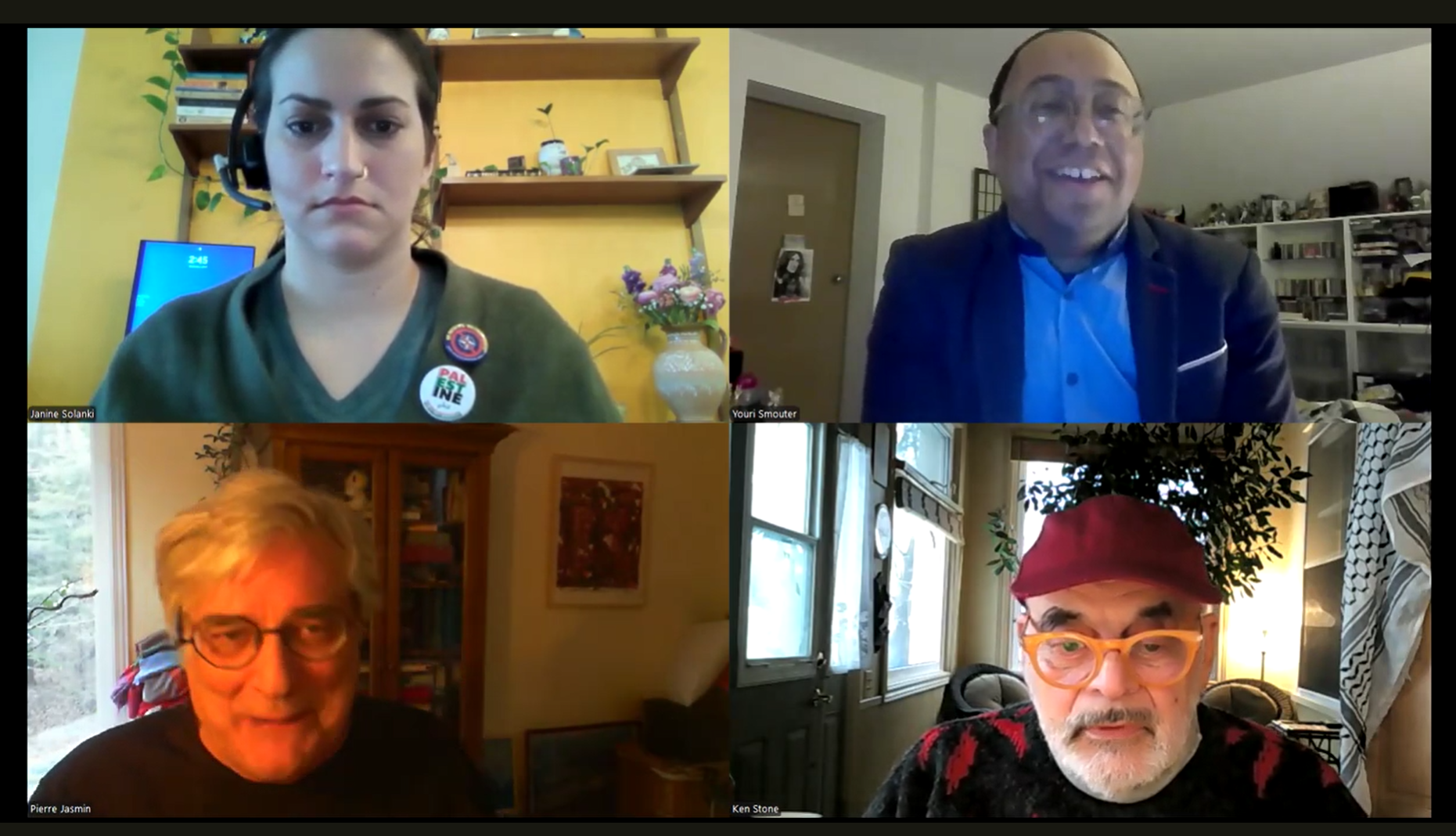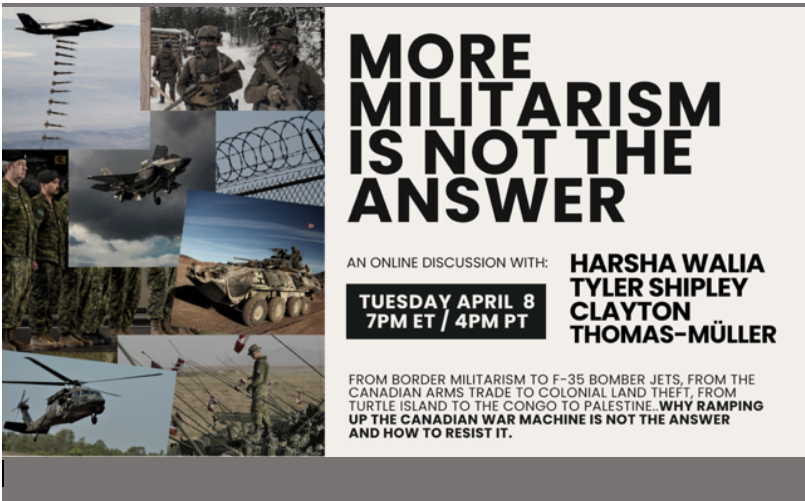
Par les Artistes pour la Paix, 7 avril 2025
Absents sur le Mont-Royal à la manif au motif ventilatoire de « dénoncer Donald Trump », les APLP appellent plutôt à une lutte commune contre les $50 milliards de dépenses militaires pro-OTAN prévues en 2030 et contre la destruction de notre environnement québécois et des rivières et terres des Premières Nations, par un pipeline de l’Est (dépenses et pipeline priorisés par Carney-Poilievre).
Car la chanson des APLP 2024, Les cowboys fringants, soulève à notre avis la véritable question prioritaire de l’urne :
“Toutes les 8 secondes
Un enfant crève au tiers-monde
Quand on sait qu’une toute petite fraction
De tous ces budgets militaires à la con
Pourrait abreuver les humains
Leur assurer un lendemain
Mais l’Occident s’en lave encore les mains
Alors que toutes les 8 secondes
Se génèrent des profits immondes
Chez les grandes multinationales
Qui croient que l’droit fondamental
D’accès à l’eau doit devenir commercial.”
Deux urgences donc, la santé des enfants que protégeaient UNICEF et l’Organisation Mondiale de la Santé – ONU, défendue par la docteure Joanne Liu, et les armements priorisés sans opposition d’aucun parti de la Chambre des Communes ni des médias. Quand un candidat vient frapper à votre porte, posez la question : « Pourquoi votre parti favorise l’augmentation des dépenses militaires, et ne nous répondez pas par vos propagandes primitives de haines vomitives anti Poutine ou Xi Jinping… »
2- À écouter : https://youtu.be/d9wue3DX8R0?si=VDcK-OnW7o-cpqQW
Cet enregistrement d’une heure effectué le 2 avril par le journaliste bruxellois Youri Smouter fait entendre tour à tour les militants antimilitaristes
Ken Stone de la Hamilton Coalition to Stop the War,
Janine Solanki, du Réseau pancanadien pour la paix et la justice, en direct de Vancouver puis
Pierre Jasmin, des Artistes pour la Paix en direct du Québec.
Youri nous enjoint à en assurer une large diffusion, d’où la version Youtube. Il félicite le panel pour l’excellente discussion et note avec grande satisfaction qu’on y a pourfendu :
– le mythe mensongèrement fabriqué par l’OTAN que « défendre l’Ukraine » serait désormais une mission de « peacekeeping ». Non, il s’agit plutôt d’une prolongation de la guerre dévastatrice en Ukraine avec une expédition dite « force internationale de réassurance composée de 100 000 à 200 000 soldats », se prétendant une opération de maintien de la paix, tout en voulant en réalité prolonger la guerre et soustraire 800 milliards d’Euros des budgets sociaux au profit des budgets militaires (Allemagne, France, Grande-Bretagne…) ;
– le rôle réactionnaire et sanglant joué en particulier depuis le bombardement de la Libye en 2011 par le Canada à la tête de l’opération aéroportée de l’OTAN;
– son abandon des objectifs de l’ONU de lutte de protection du climat, de politiques de désarmement (UNIDIR) et de protection des réfugiés de guerres (UNHCR) ;
– sa négligence criminelle face à la dégradation de la vie des plus pauvres privés de logements, y compris les Premières Nations, certaines, en outre, privées d’eau potable ;
– son surarmement adopté sans contestations ni même discussions par tous les médias.
Youri Smouter conclut par un slogan férocement antiimpérialiste : « le pouvoir au peuple ; mort aux fauteurs de guerres et marchands de mort. »
3- Voici quelques idées développées par le représentant des APLP complice de Janine et Ken:
« Compromis », son mot favori choisi à la surprise des trois interlocuteurs, Pierre l’explique ici parce qu’il OUVRE à la paix
- bloquée par les capitalistes pour qui la production d’armes développe l’économie et priorise même les budgets de la Santé et tout le reste
- bloquée aussi par des idéologues issus d’un passé communiste, avec leur tentation de « vanter le pouvoir armé du peuple » sans tenir compte des armes de destruction massive
- verrouillée par les pouvoirs religieux, alors que le mot devrait appeler à « relier ». Non,
les guerriers fanatiques religieux s’affrontent, par exemple en Palestine-Israël, ceux du Hamas et les génocidaires de l’extrême-droite Nétanyahou appuyée par Trump avec le risque d’une guerre contre l’Iran des Ayatollahs mais aussi contre les femmes et enfants iraniens.
Une autre répartie de Pierre a fait sourire, celle à la fin où il ouvre les portes du « paradis » à tous les miséreux de la Terre. Le passé catholique de sa lointaine jeunesse refait-il surface?
4- Les APLP remercient Walter Bertacchi : le 2 avril, depuis l’Université Laval, sa revue de presse environnementale régulière – qu’il tient depuis une dizaine d’années – reproduit l’article des Artistes pour la Paix; voir rp_RDU_3 (2/4/2025). L’article en question :
https://www.artistespourlapaix.org/une-paix-qui-derange/ 30.03.2025, Artistes pour la paix.
Pour consulter les archives de la RP:
https://www.zotero.org/groups/2468940/revues_de_presse_environnementale_de_walter_b :
________________
5- Notons les efforts de l’Action Network :
Action Network

6- Le 2 avril, infos relayées par Ken Stone celles contenues dans notre paix qui dérange :
7- Bien sûr, les Artistes pour la Paix se tiennent toujours à la disposition des radios ou télés québécoises, ainsi que des conférences d’Échec à la guerre.
À quand une conférence de presse COMMUNE Bloc Québécois, NPD et parti Vert pour dénoncer l’augmentation insensée des budgets militaires jusqu’à $82 milliards annuels de Carney-Poilievre ?
COMMENTARY
To: Cross Country Checkup, CBC, April 13, 2025. All war is a war on children, destroying their safety and security and sometimes their lives. It tears their parents from them and destroys their homes. It puts them on the refugee road with often nowhere safe to go. Who benefits from war? Countries, groups, and individuals bent on conquest and domination. Investors in weapons, bombers, guns and ammunition. I would like to ask your guests, “What actions do you recommend that our country and all peace-loving people and nations take to relegate the violence of war to the dustbin of history? I don’t believe that more military spending will accomplish this. I believe we need a government dedicated to finding these answers.”
Sandy Greenberg, Halifax, Nova Scotia.
The Liberal energy plan: more corporate, less climate?
Cet article antinucléaire est totalement justifié : à lire (il date du 16 avril)
ANNE LINDSEY
IN this “flag-waving” moment, where the U.S. government is threatening our sovereignty and economic well-being, amid the hype and adulation for the Liberal Leader, Mark Carney is however promoting ideas that merit a closer look. Not least his plan to “make Canada the world’s leading energy superpower” announced in Calgary on April 9.
On the surface, it looks like the perfect recipe for self-reliance in energy and building a stronger Canada. It’s an industrial development strategy meant to exploit our natural mineral resources, build needed infrastructure and create jobs.
But what kind of energy and infrastructure? If the plan includes many welcome commitments to reducing emissions: investment in zero-emission vehicles, developing battery and smart grid technologies, reducing methane, and references to our “clean energy advantage,” there is also this nagging notion of “dominating the market in conventional energy” and building out pipelines… neither of which square with the looming climate emergency, regardless of (and exacerbated by) the external pressures from the south.
The “clean energy advantage” is not well defined. Conventional wisdom suggests it includes hydropower, renewables like solar, wind, and geothermal energy, along with energy efficiency. However, although Carney mentioned “more nuclear, both large scale and small modular” in his Calgary announcement, the word “nuclear” is absent from the written plan.
Why? Nuclear is a controversial energy technology, for good reason. It seems inevitable that nuclear power will play a starring role in Canada’s energy future but not one the Liberals want to highlight.
Nuclear’s proponents might be winning the semantic battle branding it as “clean,” despite its routine operations releasing a cocktail of radioactive substances, its waste products containing among the most dangerous elements on the planet, and its inextricable link to the manufacture and proliferation of nuclear weapons.
Federal Liberals (and for that matter, Conservatives) have always been pro-nuclear, even though no nuclear plants have been built in Canada for decades. The annual federal expenditure on Crown corporation Atomic Energy of Canada Limited is more than $1 billion, due in no small part to the massive liabilities of managing nuclear waste. Tax credits for nuclear companies already abound.
Just this year, in the month of March alone, the current Liberal government committed another nearly half a billion dollars to a variety of nuclear projects across the country. The plan may not talk, but money does.
Mark Carney himself, a former UN special envoy on climate change and finance, has said there is “no path to net zero without nuclear.” In 2022, he joined Brookfield Asset Management, a firm holding both renewable energy and nuclear portfolios that, together with uranium giant Cameco, purchased bankrupt reactor company Westinghouse, under his watch. No question that Carney has a strong pro-nuclear bent.
More nuclear energy is an inappropriate climate action response, for at least two reasons. First, reactors take decades to be licensed, constructed and connected to the grid. And that’s a luxury we can’t afford.
Business as usual while waiting for nuclear power to get online means we surpass the tipping points of global warming, a scenario we must avoid.
Second, nuclear is the costliest way to generate electricity. Studies by organizations from the Ontario Clean Air Alliance to Lazard show that nuclear is not competitive with renewable alternatives which continue to drop in price. As governments fund nuclear, there is a massive lost opportunity cost for developing cheaper and readily available renewable energy.
Nuclear is too slow and too expensive to address climate change. The IPCC shows nuclear to be inefficient in reducing emissions. This is not an ideological perspective. It is fact.
Besides, “new generation” reactors being touted in Canada (such as GE Hitachi’s BWRX-300) carry a massive political liability, given current world events: most are American designs and all require enriched uranium fuel fabricated outside Canada.
Hardly a prescription for self-sufficiency. It’s a bit mysterious why “nuclear” does not appear in Liberal election plans while getting so much government (Liberal and Conservative) attention and money — unless we recognize the essential role of civilian nuclear infrastructure in maintaining weapons of mass destruction. Canada was instrumental in building the first atomic bombs and remains central to today’s U.S. defence/weapons supply chains for critical minerals, including uranium. Let’s keep that in mind as leaders negotiate trade and tariffs.
Canada should define itself not by becoming an “energy superpower” in the conventional and nuclear sense, but by disengaging from the defence industrial complex. We should use our critical minerals, ingenuity and workforce to pursue a decentralized, affordable, locally based renewable energy infrastructure leaning heavily into building and transportation efficiencies. We need to work together with Indigenous and remote communities, fully understand environmental and social impacts of developments and create smart grid interconnections that allow for maximum flexibility in energy sharing within Canada.
Anne Lindsey volunteers with the No Nukes MB campaign of the Manitoba Energy Justice Coalition and has been monitoring nuclear waste since the 1980s.
Cet article est important, peut-être notre membre Claude Saint-Jarre trouvera le temps de le traduire?
le temps est une chose, la capacité une autre; je ne traduis pas solo pour des gens, je suis cahin caha pour moi.